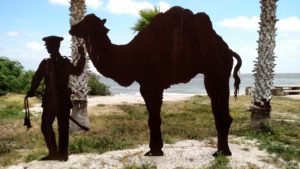Tin-type camera was patented by Hamilton Smith of Gambier, Ohio, in 1856. Idea: Children could learn how the tin-type was different from other kinds of cameras.

Historical Marker Camel Corps in Indianola, Texas
Thirty-four camels landed in Indianola, Texas, in 1856! After the United States won the Mexican-American War in 1846, the country acquired large land holdings in what is now Utah, Nevada, New Mexico, Arizona, and California. The American army wanted to map the region and establish forts in the new lands. Horses and mules could not easily withstand the high temperatures, lack of consistent water, and rough terrain. The army decided to try camels as beasts of burden. The camels marched from Indianola to base camp at Camp Verde, Texas. Eventually another 41 camels arrived. The camels were well-suited to the terrain and climate; the Camel Corps trekked all the way to the Pacific Ocean and back. Unfortunately, the Civil War disrupted the region, and the camel experiment ended.

Flag of Norfolk Island
Norfolk Island celebrates Bounty Day. This self-governing territory of Australia honors the day in 1856 when Pitcairn Islanders on the Bounty landed on its shores. This tiny island (about 0.2 the size of Washington, DC) supports about 2,200 people. Kingston is the capital. Children can learn more at: Norfolk Island.